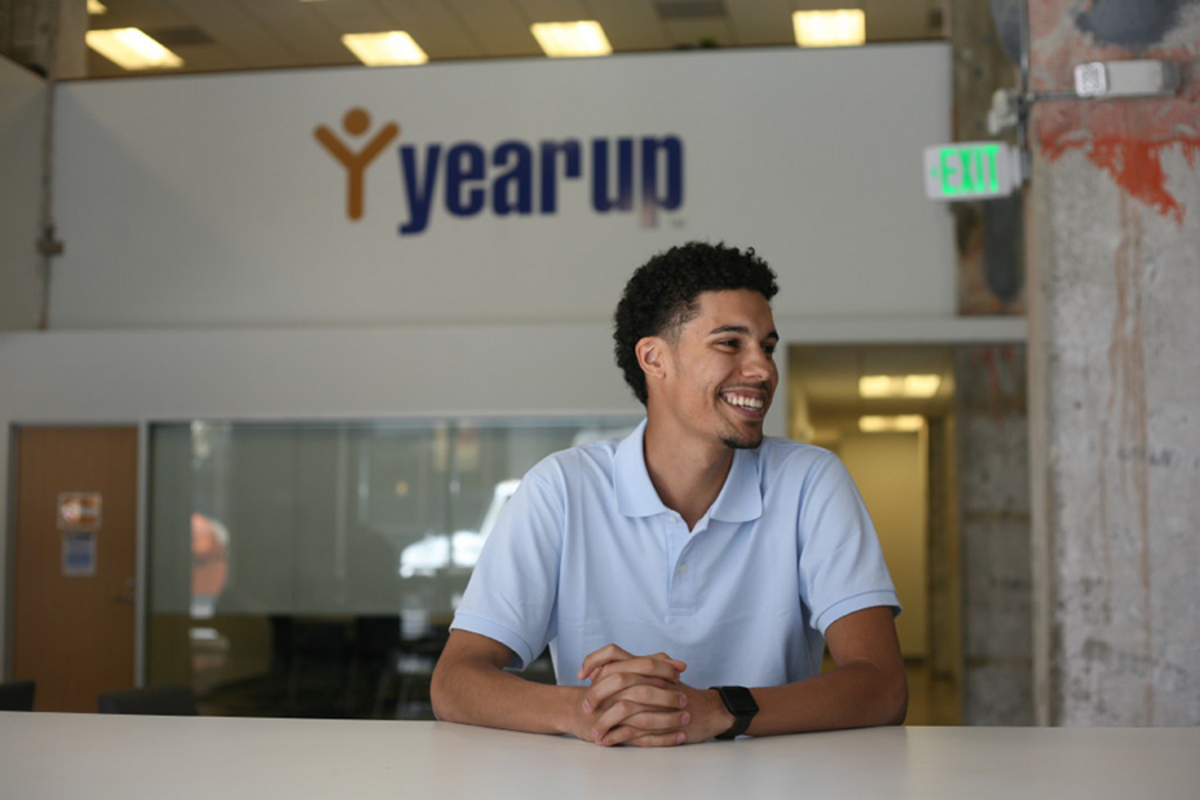Year Up matches urban youth to a hungry job market
Loading...
| San Francisco
On his daily commute across the bay, Marcus Stevenson looks up at the new Salesforce tower under construction in downtown San Francisco and thinks: I’m going to work there someday.
“It’s really inspiring because I can see it from my house, all the way in the East Bay in San Leandro,” says Mr. Stevenson, who has been interning for the tech company for about three months. He chuckles at his newfound ambition. This time last year, the 22-year-old was stocking inventory at a grocery store and thinking only about his next paycheck.
“What I wanted was just to be promoted at Whole Foods,” Stevenson says, marveling at the turn his life has taken. “Today I’m looking at what decisions I can make that’ll help me get to that spot 10 years from now, where I can be a certified representative of my company and travel around the world.”
His new attitude comes after about nine months at Year Up Bay Area, the San Francisco chapter of a national nonprofit that provides urban youth with the skills, support, and experience they need to launch stable, profitable careers. Students – mostly young people of color from low-income families – spend 40-hour weeks learning everything from how to troubleshoot a computer and draft a business plan to how to write thank-you notes and give an authoritative handshake.
After six months, each student is placed as an intern with one of Year Up’s corporate partners.
“It’s kind of like a finishing school and a technical school at the same time,” says Renée Archer, the organization’s lead IT instructor.
It’s a model that’s beginning to gain steam in the workforce development world, as continuing demand for – positions that require postsecondary and often specialized training – clashes with the rising costs of higher education. From California to Texas to New York, organizations are developing strategies to effectively equip young people like Stevenson with in-demand skills and connect them to the sectors and companies that need them most.
These efforts don’t yet constitute a movement, researchers say. But there is growing interest in evaluating what these groups have learned in terms of turning out graduates who can land and sustain middle-class jobs – and what it takes to level the playing field for young people who lack the opportunity and resources to complete a traditional college-to-career path.
“The most successful organizations work strategically to connect people to good jobs they can’t get on their own,” says Mark Elliott, president of the Economic Mobility Corporation (EMC), a research group in New York City that evaluates workforce training initiatives, including Year Up. “If we really want to make a difference in people’s lives, the opportunity is there. We just have to be willing to make an investment.”
Adjusting to new mindset
Like most Year Up students, Stevenson joined the program feeling hopeful but uncertain.
After high school he had powered through community college, relying on his supermarket job to keep him afloat. He earned an associate’s degree in social sciences after four years, only to find that no one would hire him because he didn’t have enough experience. “I tried to get a county job. I must have applied to any library within a 30-mile radius of my house,” Stevenson says. “I was not qualified enough.”
He considered applying to a four-year institution, but reeled at the cost. His dad is a caretaker for the local parks and recreation department, and his mother is a stay-at-home-mom who occasionally picks up restaurant shifts. Neither would have been able to support him for another four years at school, he says. “I’m making $11 an hour,” Stevenson recalls thinking. “I can’t take out a $30,000 loan.”
When a friend at work first told him about Year Up, he thought it was a scam. A program that practically promised a job in tech after a year of training? A place where people used phrases like “growth mindset” and attended things like Monday Morning Kickoff? “It was hard to buy in at first,” he says.
But Stevenson was tired of working a job he didn’t care about. He wanted to challenge himself and grow. He decided to commit to the program, “corny stuff” and all.
It was easier said than done, he says. Year Up strictly enforces its rules: Everybody has to dress professionally and come in on time. Swearing and cell phones are prohibited in the building. And while one of Year Up’s main distinctions is the stipend – every student gets $150 a week to attend – a major infraction equals a $15 pay cut for the week. Students also follow a point system that tracks their infractions, and everyone’s points are read out every Friday.
The “ROTC model,” as Ms. Archer calls it, teaches students to be accountable for their actions, and ready to give and receive useful feedback.
Stevenson says he grappled with those requirements – and the changes he had to make to fulfill them. “It was forced and fake at first,” he says. “Like, who am I? What am I turning into?”
But over time he saw his writing and public-speaking skills improve. He grew more confident in his ability to face a range of challenges and social situations. He found he could take constructive criticism without feeling personally insulted. And he began to embrace this new side of him as part of the man he was becoming.
“We’re allowed to be different people in different situations,” Stevenson says. “I’m realizing that this person was always who I could’ve been, but I never had the insight to bring it out.”
The positive response goes both ways. Year Up’s corporate partners see the program as a way for them to help address a societal issue while benefiting from the skills Year Up students offer. As program veterans like to say, “It’s not a handout, it’s a hand up.”
“This is not philanthropy,” says Carrie Varoquiers, vice president of global impact at Workday, a San Francisco company that develops financial and human resources software. “We are getting access to great talent that comes from every background. This is adding value to our business.”
“If you want someone who can look you in the eye and tell you feedback about the work environment, you ask a Year Up student,” adds Ebony Frelix, senior vice president for philanthropy and engagement at Salesforce. "These interns are taking leadership roles. All these kids have needed is an opportunity.”
Close relationships with corporate partners
In 2014, by the EMC found that participants earned nearly $13,000 more than their peers three years after completing the program, with wages averaging at $14.21 an hour compared to about $11.70. Year Up graduates were also significantly more likely to be working full-time in IT or finance.
Other organizations that have developed similar models over years – and sometimes decades – have seen comparable success. The Jewish Vocational Service in Boston, Per Scholas in New York, and the Wisconsin Regional Training Partnership in Milwaukee were all shown to have had on participants’ earnings over time.
Another that more recently caught researchers’ attention is Project Quest in San Antonio, Texas. Program graduates were earning about $38,000 a year , compared to an average of $11,400 before enrolling, according to a study also conducted by the EMC. Notably, even those who dropped out were making double their income before joining the program. The project at least three other initiatives across the state.
Part of the secret, Elliott says, is a combination of factors that include being attuned to current and future employer demands in a specific region; offering curriculum that teaches corporate behaviors and attitudes as well as technical skills; and providing support at all levels of the program – even after the initial job placement.
The best programs also build close relationships with corporate partners who are willing to invest significantly in student success. Year Up, for instance, receives 60 percent of its funding from its employer partners, who spend about $25,000 per student.
They’re also flexible. Salesforce began its partnership with Year Up with a focus on interns with an IT background, Ms. Frelix says. Over time the company realized it also needed people with training in project management and quality assurance – both of which are now designated tracks at Year Up. “We were able to go to them and say, ‘We need other skills,’ ” Frelix says.
“They’re adapting and changing all the time as the economy and the labor market changes,” Elliott adds.
But the intensive and customized training that makes these initiatives successful has also made broadening their impact a challenge.
“These programs are privately supported. They’re not operating at scale,” says Shayne Spaulding, a senior research associate at the Urban Institute in Washington and former director of workforce development for the City University of New York. For that to happen, she says, industry and government will have to come together and invest more than the usual time and money into crafting feasible strategies.
In 2014, the federal government showed its continued support for workforce training by extending the Workforce Investment Act of 1998 through 2020. The WIA primarily funds one-stop career centers that help low-income youth and families prepare resumes and find work.
“But there’s not enough money in substantial investments in individual participants,” Elliott says. “Without more resources, the amount we’re investing is really small.”
Pushed to meet the challenge
Those who do gain access to programs like Year Up say the opportunity is transformative.
Valentino Lei’a, who spent the latter years of high school living with friends while his mom tried to overcome her alcohol addiction, says he never imagined he would break into the tech industry. When he joined Year Up in 2014, he was coasting through community college with a vague plan to teach physical education.
“I was fine with sticking in the corner and not saying a word,” Mr. Lei’a says. “But I wasn’t given the luxury to sit in the back. I had to participate. You’re pushed to challenge yourself.”
Today, at 22, Lei’a works full-time as a quality assurance engineer at Workday. When he started in 2015, he says, “I couldn’t wait to make $20 an hour. Now I’m coming from the perspective of, ‘Man, $20 an hour? I won’t accept that.’ ”
Stevenson, who’s halfway through his internship at Salesforce, is seeing his horizons open up, as well. He’s found himself a mentor and hero in Tony Prophet, the company’s chief equality officer. He envisions a future where he gives keynote speeches about product releases in cities like Amsterdam and New York. And he brims with a confidence he admits he didn’t have even a few months ago.
“I feel like I’m just as smart, I feel like I’m just as qualified as some of the people I work around who have their bachelor’s in this and their master’s in that. And I just didn’t have the opportunity to show it,” Stevenson says. “Year Up gave me that opportunity. As long as you earn it, it levels the playing field.”





